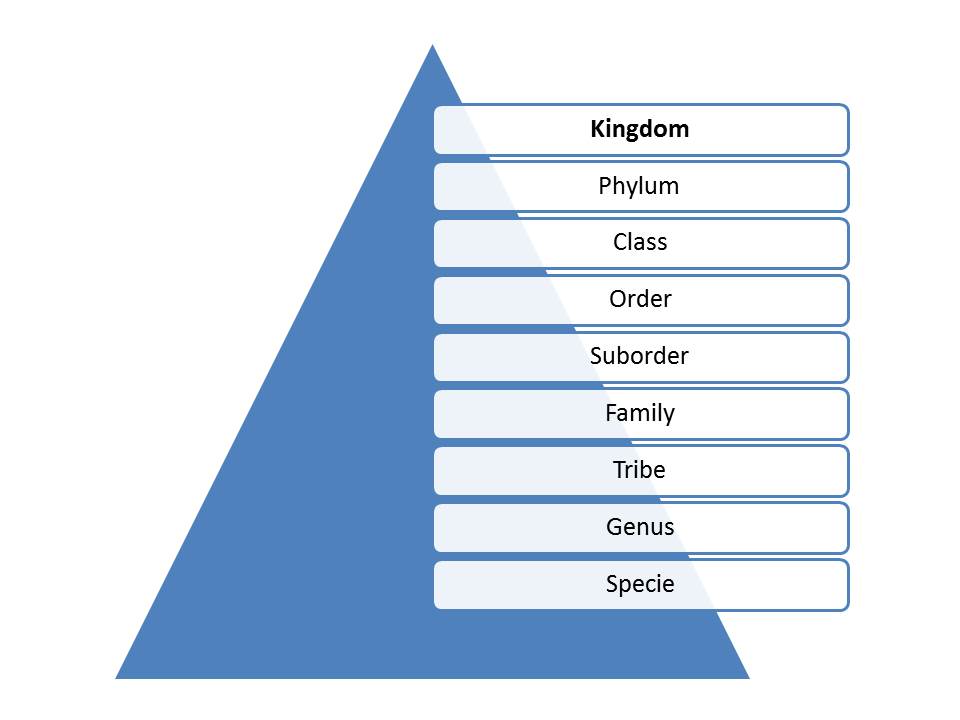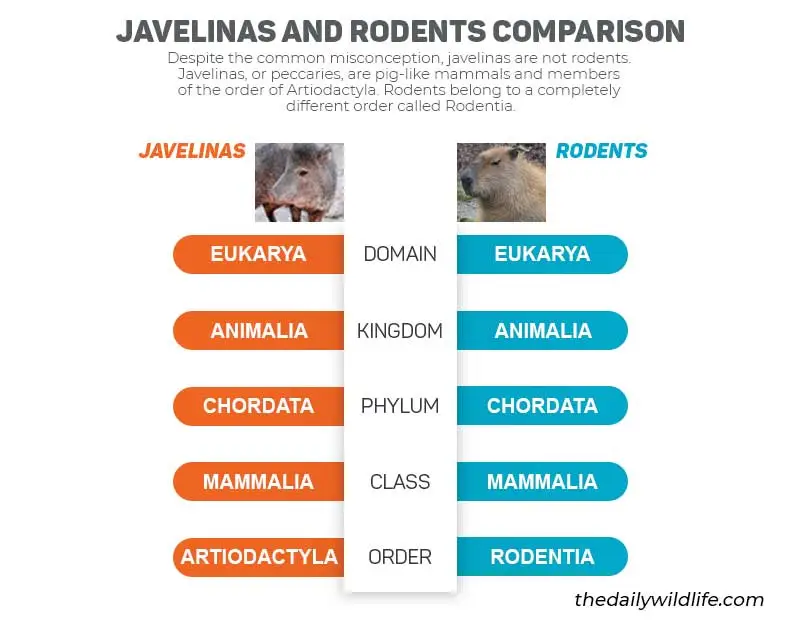Javelinas are funny-looking animals people keep as pets and as a source of food.
However, there’s some confusion out there about whether javelinas are rodents, and which animal family the javelina falls into.
In this post, we’ll address some widespread misconceptions and break down the differences between the two.
A quick note: Javelina is a term used to refer to one species of peccary as well as to the entire family of these animals. In this article, we will refer to all peccary species as javelinas.
Table of Contents
Are Javelinas Rodents?
No, javelinas are not rodents. Javelinas, or peccaries, are pig-like mammals and members of the Tayassuidae family. They are one of the 270 species that belong to the order of Artiodactyla.
Rodents, on the other hand, belong to a completely different order called Rodentia. Javelinas are not classified as rodents, and also belong to a different clade.
Javelinas Are Taxonomically Different From Rodents

In biology, there are millions of different plants, animals, bacteria, fungi, etc. Scientists organize all of these organisms into different groups called taxa.
Remember how a grocery store is organized?
One huge building is divided into departments such as fruit, dairy, meats, cosmetics, etc.
Then, each department is further divided into aisles, every aisle into categories and brands, and then finally we get to the individual products. This organization from larger to smaller, more specific categories, is called a taxonomic hierarchical system in biology.
At the top, the largest category is called domain.
Within each domain, there is a second category called a kingdom.
After kingdoms, the subsequent categories are phylum, class, order, family, genus, and species.

Javelinas and rodents belong to the same kingdom, Animalia, or animals. They are both members of the same phylum, Chordata, and of the same class, Mammalia, or mammals.
This is where the relationship between these animals stops; rodents are members of the order Rodentia, while javelinas are members of the order Artiodactyla, the even-toed ungulates.
If we go even further, the differences between the two increase.
Javelinas belong to the Tayassuidae family, while rodents can belong to one of 30 different rodent families.
This means that javelinas are also not members of the rodent family.
What Are Rodents?
Rodents are small, gnawing animals that have no canine teeth and whose incisors continuously grow. Specifically, they have two pairs of sharp incisor teeth, one pair in the lower and another in the upper jaw.
Those long teeth help rodents gnaw food, excavate burrows, and defend themselves.
The rodent family is the largest order of animals today – scientists estimate that almost half of all mammal species are rodents. They are native to all major landmasses except for New Zealand, Antarctica, and several oceanic islands, but people have been slowly introducing them there as well.
They are a very adaptable and widespread group of animals; rodents can be found in almost every terrestrial habitat, including human-made environments.
Examples of rodents include mice, rats, squirrels, prairie dogs, porcupines, beavers, guinea pigs, and hamsters. The largest species of rodents is the capybara, which can weigh as much as 146 pounds.
Why Are Javelinas Not Rodents?
Javelinas are not rodents because they belong to a different mammal order.
Because of their unique foot morphology, javelinas belong to the Artiodactyla order, together with pigs, llamas, camels, sheep, giraffes, and others.
Javelinas are omnivorous, feeding on a variety of plants, small animals, and carrion.
Javelinas also have big and scary canines.
Unlike javelinas, most rodents are herbivores and feed on plants. They also have a single pair of continuously growing incisor teeth in each of the upper and lower jaws. And unlike rodents, javelinas have canine teeth.
Javelinas Are A Lot Different Than Rodents
Javelinas are medium-sized animals native to Central and South America, Trinidad in the Caribbean, and the southwestern parts of North America. They usually weigh between 40 and 90 pounds and get between 2 ft 11 in and 4 ft 3 in long.
Javelinas have characteristically long dark coarse hair, large heads, circular snouts, and hooves just like camels.
Most rodents, on the other hand, are small animals with robust bodies, short limbs, and long tails. Rodents love to live underground and build a series of tunnels using their strong teeth and dexterous paws (not all, of course). Rodents do not have hooves as javelinas do.
Javelinas might sleep in caves and cave-like areas, but they do not burrow like rodents. Rodents also have long incisors teeth they use to gnaw and do not have canine teeth; javelinas have short and straight canine teeth, or tusks.
Are Javelinas Related To Pigs?
Yes, javelinas are related to pigs. Javelinas and pigs are members of the same suborder called Suina.
Javelinas might belong to the same class as rodents, but this doesn’t mean they are closely related. Humans are also mammals, and we do not consider rodent squirrels as our close relatives.
Javelinas are called New World pigs that belong to the Tayassuidae family. Some 30 million years ago, javelinas and feral domestic pigs of the Old World had a common ancestor. Both belong to the same suborder of omnivorous, non-ruminant artiodactyl mammals, called Suina.
Javelinas and pigs share a lot of visual similarities and differentiate in certain skeletal and dental features.
Javelinas evolved in Europe and spread across much of the world.
Then, during their evolutionary history, javelinas moved from Europe to North America across a land bridge that existed at the time and left the old world pigs behind.
Some 3 million years ago, they moved into South America.
With no competition from their old-world counterparts, javelinas colonized the Americas and still live there today.
Rodents, unlike javelinas, are considered to have originated in Asia. According to a 1994 study, they first appeared in the fossil record in the late Paleocene in Asia, about 54 million years ago. Rodents descended from rodent-like ancestors called anagalids.
Read More: Do foxes belong to the rodent family?
How Many Species Of Javelinas Are There?
There are three species of javelinas.
The collared peccary (Dicotyles tajacu) is the smallest and the most common species of javelinas. They are easy to notice by the pale stripe around the neck.
The white-lipped peccary (Tayassu pecari) is slightly darker and larger than collared peccary and can be mostly found in rainforests of Central and South America.
The Chacoan peccary or tagua (Catagonus wagneri) is the largest and the least common peccary species. They are only found in the dry Chacoan region of South America and scientists estimate that there are between 3,000 and 5,000 of these javelinas alive.
Read More: Do Otters Belong To The Rodent Family?
Final Thoughts – Are Javelinas Rodents?
In conclusion, javelinas are neither marsupials nor rodents. Javelinas are animals that belong to the order of even-toed ungulates, Artiodactyla.
The main difference between javelinas and rodents is that javelinas are omnivores and do not have as pronounced incisor teeth as rodents do. Most rodents are herbivores and lack the canine teeth of javelinas. Javelinas do not burrow like rodents, and rodents do not have hooves, as javelinas do.
Rodents are the largest order of small mammals, and one of the most common of all animal types.
If you were pondering on the question “are javelinas rodents”, we hope this article removed all doubts.
And if you enjoyed it, here’s a recommendation on another very popular javelina read: How Dangerous Are Javelinas?